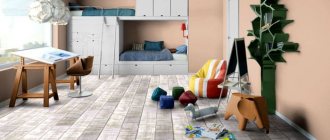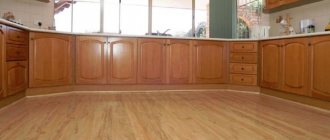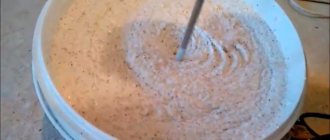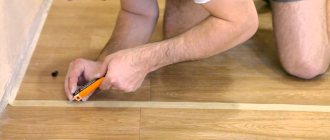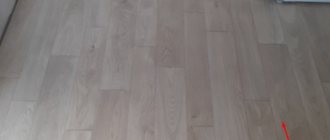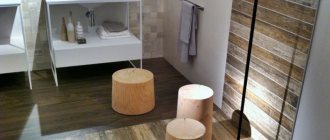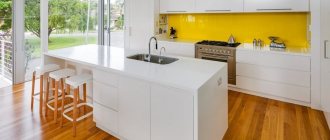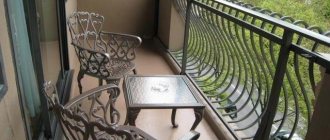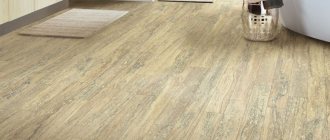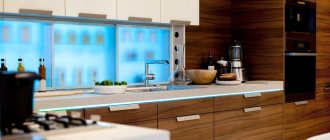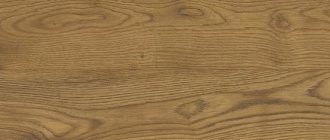Features of choosing linoleum with a tile pattern
Today, linoleum is one of the most popular floor coverings. It differs into three types depending on the scope of application and the level of required load:
- Domestic. Thickness is about 1.5 cm. Designed for low-traffic areas: usually residential apartments and houses. The strength level is low, but the service life is at least 5 years.
- Semi-commercial. More wear-resistant due to the dense backing and special protective composition that covers the surface. This material is installed in areas with high loads.
- Commercial. Suitable for shopping centers, medical and educational institutions, where the material is exposed to maximum weight load on a daily basis. The highest quality, service life is about 40 years.
Laying tiles
What do we need?
As we noted above, one of the advantages that this flooring has is its relatively simple installation, which can be done with your own hands.
If you decide to implement a similar project, you will need:
- A set of marking tools - cord, tape measure and marker.
- Metal or wooden square.
- Spatula and grater for applying tile adhesive.
- Linoleum cutter.
Advice! It is better to use a knife with replaceable blades, since the quartz filler is quite a strong abrasive, and the sharpness of the cutter will decrease very quickly
- Rubber roller for the floor.
Trimming with a square
We will also need linoleum glue - unless, of course, you are installing a self-adhesive type of material.
Preparation and styling
The instructions for installing linoleum tiles are quite simple:
- First we level the base. We clean the concrete floor from dust and debris, we open up and seal the cracks, we knock down large bumps with a hammer drill.
- If there are large irregularities, we lay a self-leveling screed on the floor.
- It is also possible to install a subfloor made of plywood with a thickness of at least 8 mm.
Next, we proceed directly to the work of laying tiles:
- We bring the material into the room, open the packaging and let the linoleum rest for at least two days. At the same time, PVC adapts to the temperature conditions of the room, which will further minimize deformation.
- Using a tape measure, a measuring cord and a marker, mark the base. We pay special attention to open areas, since this is where defects in installation will be most noticeable.
Advice! To avoid problems during installation, experts recommend first laying out all the tiles without glue.
Simple sticker technology
Self-adhesive models are very easy to install - just remove the protective film and press the tiles to the leveled base.
But with ordinary tiles there will be a little more fuss:
- We mix acrylic dispersion adhesive or purchase a ready-made composition designed specifically for laying tiles.
- Apply glue to the base in a layer of 1.5 - 3 mm. In this case, the consumption should be approximately 0.3 - 0.4 kg/m2 of floor area. Let the glue sit for at least 5-10 minutes before starting work.
- We begin gluing vinyl tiles from the corner of the room, leaving a gap along the walls of about 5-10 mm. When laying the material, we try to ensure that no large air bubbles remain underneath it.
Photo of the finished coating
Advantages and disadvantages
Linoleum tiles combine many advantages, but also have several significant disadvantages:
| pros | Minuses |
| Combines the appearance of ceramic tiles and the unique characteristics of rolled linoleum. | Not resistant to weight loads: heavy furniture may cause dents. |
| Easy to install and dismantle, does not require special skills. Unlike tiles, there is no need to work with seams. | If the coating is damaged, it is impossible to replace one fragment: the entire canvas must be replaced. |
| It has good heat and sound insulation thanks to the substrate, which retains heat and absorbs sounds. | Unlike its tiled counterpart, it is not resistant to fire. |
| Does not cause difficulties during cleaning, resistant to moisture. | Only high-quality coatings can convincingly imitate a tiled floor. It is considered the world leader in the production of linoleum. |
Features of finishing material
Linoleum is made from synthetic components that are resistant to high humidity. The material is easy to care for and simple to install.
A couple of decades ago, such a coating was found in almost every apartment. For this reason, there is an opinion that this is an unaesthetic option for floor design, which will make even a carefully thought-out interior look cheap. But modern technologies refute this view of things and make it possible to create high-quality types of linoleum with patterns that realistically imitate expensive finishing.
This is interesting! Initially, linoleum was made from natural, environmentally friendly materials. The cost was high, so it did not gain much popularity. Then manufacturers began to use synthetic components.
Linoleum is a kind of “sandwich”. And each of its layers performs its own function.
Material structure:
- Base. In the most budget models it is foamed PVC. Fiber material is used for floor coverings with increased thermal insulation and noise protection.
- Reinforcing coating. Not used in all brands of linoleum. It increases the strength of the material. Made from jute or fiberglass.
- PVC base layer. It is on this that the drawing is applied.
- Drawing. Made with alkyd or acrylic paint. Photo printing is most often used.
- Protective transparent layer. Liquid polyurethane is applied in several layers; it can also protect the lower layers from moisture.
- Additional texturing of the polyurethane layer. This manufacturing stage makes the imitation of tiles or any other material more realistic.
Thanks to many layers, modern linoleum coverings are durable and stylish in appearance. In addition, manufacturers can use additional layers, for example, with an anti-slip effect.
Design, shapes, drawings
The design of the coating differs in the types and sizes of “tiles”, as well as in the variety of patterns: linoleum can be striped, patterned, checkered, diamond-shaped or honeycomb-shaped.
Squares
The pattern in the form of squares can be called traditional. It is suitable for both Provence and minimalist interiors. The squares serve as inserts on a plain background or alternate, making up a cellular pattern.
The photo shows a children's room with glossy linoleum made of large squares.
Diamond
A stylish and therefore common option with rhombuses that are connected into a voluminous geometric pattern.
The photo shows textured linoleum imitating tiles made of graphic rhombuses.
Under marble tiles
Coatings that imitate marble or products with marble chips look expensive and natural.
The photo shows a bright bathroom with linoleum in the form of white marble tiles. Thanks to the texture, the coating looks even more expressive.
Under porcelain stoneware
Imitation porcelain stoneware looks convincing due to its matte finish and natural stone pattern.
Patchwork
Multi-colored patchwork gives the interior coziness and adds bright colors.
With patterns and ornaments
Canvas with ornaments should be laid in a room with plain walls and furniture so as not to overload the space.
The photo shows a snow-white kitchen, where the patterns of semicircles echo the shelf holders.
Honeycomb or hexagon
Hexagons on the floor, fashionable in the 90s, are returning, but not in brown, but in bright colors:
The photo shows imitation blue tiles, contrasting with a dark set.
Vinyl tiles: material overview
Structure
As we noted earlier, tiles made from polymer materials have been used for finishing floors for quite a long time. However, the old modifications were not of high quality, and therefore the coating degraded very quickly, especially with intensive use.
The main reason here lies in the structure of the material: previously, single-layer square or rectangular sheets of polyvinyl chloride were used for laying on the floor. Naturally, the rather thin plastic could not effectively withstand the loads.
Multilayer structure
The linoleum and PVC tiles used today for flooring have a more complex multilayer structure:
- The base is a sheet of polyvinyl chloride (vinyl) about 0.5 mm thick. This layer is responsible for the adhesion of the finishing material to the base and gives the product elasticity.
- A reinforced base layer of softer PVC is glued on top of the base. Durable fiberglass fabric is used as reinforcement.
- Next comes the base, the thickness of which can reach 2-3 mm. The base is made from flexible vinyl with the addition of fine-grained quartz sand. The base acts as a stabilizer, providing the basic performance properties of the material.
- A decorative layer is glued onto the base: thick paper with a printed pattern. In some cases, the decorative layer is made textured.
Natural wood texture
- High-quality varieties of linoleum panels are covered with a polyurethane layer. Polyurethane with additives protects the material from abrasion and prevents fading under the influence of ultraviolet radiation.
Note! In some types of coating, anti-slip additives are introduced into the polyurethane, which ensure comfortable movement even on a wet surface.
This design has a number of advantages. On the one hand, the multilayer structure is quite stable, and therefore the coating can easily withstand both foot traffic and washing using modern household chemicals. On the other hand, the presence of several layers of different densities provides quite effective shock absorption, and walking on the tiles is just as pleasant as walking on high-quality linoleum.
Main varieties
If previously only linoleum with tile imitation was available on the market, today you don’t have to make compromises and purchase a real tile covering.
Moreover, there are quite a lot of varieties of such finishing materials.
- The shape of the panels can be square, rectangular, triangular and hexagonal. The last option is especially worth highlighting, since it is often used to create the most original designs on the floor.
- Depending on the type of surface, there are glossy, matte, textured and anti-slip (abrasive) coatings.
Advice! In residential premises, you should not replace linoleum with tiles with an abrasive layer - socks and soft slippers will become unusable very quickly. But for public buildings this coating is perfect.
Abrasive models are suitable for public buildings with high foot traffic
However, the main differences lie in the production method:
- Quartz-vinyl tiles contain up to 80% ground quartz sand. The manufacturing technology includes a hot pressing stage, which makes it possible to obtain very durable and dense products. At the same time, quartz provides increased resistance to friction.
- Pressed tiles are made from vinyl, resin, plasticizers and hardeners. Its mechanical properties are inferior to those of quartz material, but are many times superior to ordinary linoleum.
- Self-adhesive PVC panels . They are characterized by increased elasticity, therefore they can be used not only for finishing floors, but also for decorating walls, furniture, etc. The structure is practically no different from thin linoleum.
Flexible self-adhesive variety
As for design, the choice here is quite wide. The so-called palace tiles and linoleum, which imitate the texture of natural wood, are considered favorites among the craftsmen. However, you can also find more exotic colors, even simulating crocodile skin patterns.
Advantages and disadvantages
Like any other material, linoleum tiles have advantages and disadvantages.
Let's start with the good stuff!
- High-quality varieties are highly durable. Damaging the material is much more difficult than scratching or breaking through ordinary linoleum.
- The multilayer structure provides flexibility and elasticity, which not only facilitates installation, but also makes walking on the tiles more comfortable.
- The polyurethane coating protects the core from moisture and ultraviolet exposure.
- The small dimensions of the panels greatly facilitate installation: working with tiles is much more convenient than turning a multi-meter roll of linoleum.
Simple installation is one of the advantages
Note! The fire resistance of the material is also a plus. Most high-quality models are classified as flammability class G-2 (moderately flammable). In addition, when burned, the material releases a relatively small amount of toxic substances (toxicity class T-2).
As for the minuses, they are not:
- With prolonged exposure to loads (heavy cabinet, desk, etc.), dents remain on the material, which disappear only some time after the weight is removed.
- In inexpensive models, the polyurethane layer does not effectively protect the decorative film from fading.
- The price of the material is comparable to the cost of laminate, so it is unlikely that you will be able to save money when choosing linoleum tiles.
Colors
The modern market offers linoleum with a palette for every taste. The exquisite black and white combination of tiles laid in a checkerboard pattern or diagonally remains popular.
Light, pastel colors are also in use: gray, beige, white. Brown is used to imitate natural materials.
The photo shows a children's room in soft colors. The tile covering fits perfectly into the bright interior.
The original shades for floor decoration are purple, black and green. It is recommended to combine them with other, more restrained tones.
Additional coating protection
The production of modern coatings, including linoleum, takes place under constant quality control. Companies annually invest a lot of money in improving their products in order to attract more customers to purchase new material.
For example, modern types of linoleum are coated with anti-slip coatings that guarantee protection that tiles cannot boast of. Such protection is resistant to various influences and is not subject to deformation even in difficult living conditions with a long service life.
Photo of linoleum for the kitchen under the tiles
Linoleum under tiles is a frequent guest in the kitchen, since this room is highly susceptible to contamination due to constant cooking. The pattern in the form of a cage is especially popular, and warm red shades add richness and homeliness to the interior.
The photo shows a kitchen with square tile flooring. The smooth, high-quality fabric retains its shine even in a room prone to frequent contamination.
The porcelain stoneware floor does not lose its relevance. It is also attractive, but linoleum has the advantage that the absence of seams makes cleaning easier.
A common option is canvas with patterns. They are not noticeably dirty, but such an active floor will play well either in a large room or with neutral walls and furniture.
Unusual combinations of shades and shapes (for example, multi-colored mosaics) will be appreciated by creative people.
Features of laying PVC coating
Before you start laying, you should remove all the furniture from the room so that nothing interferes with taking measurements and laying the floor evenly. The covering is laid in stages.
The plane must be checked for the presence of irregularities. Concrete floors are treated with a primer to strengthen the screed and reduce adhesion. There should be no defects, cracks, depressions, or bulges left on the base for the tiles. In case of severe distortion, the screed is filled with a ready-made or cement-sand mixture. You can also lay sheets of plywood with a thickness of 0.8 cm.
Before laying, the tiles must be brought into the room to adjust the temperature. This will reduce the deformation of the material after installation.
The tiles are first laid without gluing. To check the markings are correct and see what the final finish will look like.
The protective film is removed from the back of the tiles, and the material is pressed against the prepared base. The room temperature should be at least 22 degrees.
In some options, the tiles are combined with laminate parquet, which allows you to zone the room. This gives the room originality.
Ideas for linoleum in the interior of a bathroom
Visually, this coating is hardly distinguishable from tiles. For special similarity, manufacturers even imitate tile seams. But unlike tiled floors, linoleum is much more pleasant to the touch and warmer.
The photo shows a bathroom with linoleum under patchwork tiles.
Linoleum is moisture-resistant, therefore, just like tiles, it is appropriate in the bathroom and toilet, but it costs much less.
The photo shows a spacious bathroom in a country house, the floor of which is covered with linoleum.
Linoleum color
If you need the floor to stand out against the background of the interior (for example, you bought a very unusual flooring and want it to become the main decorative element), choose colors that will contrast with the furniture and walls. You can also buy several decorating elements to match the linoleum to make the design look more harmonious.
If the furniture and walls in the room are of rich colors, choose linoleum to match the tiles in neutral colors - beige, gray, light green. If you need to create a cozy atmosphere in the room, choose pastel shades.
Bright rich color of the floor covering in a wooden boiler room
It is recommended to choose linoleum under white tiles where there are no pets or small children. Although, this is only a factor that will allow you to wash the flooring less often (if you love cleanliness and constantly clean, then why not buy white linoleum). The color goes well with modern interiors, visually expands the space, and the furniture seems lighter.
Light linoleum in a studio apartment
You can also buy linoleum made in different colors, but this coating is suitable for creating bright, sunny interiors. To create a calm environment, a monotonous color coating is more suitable.
Linoleum tiles can have a diagonal pattern. This option is suitable for small rooms (as it allows you to visually expand the space) and where energy is required (for example, it would not be very relevant for a bedroom).
Black and white kitchen emphasizes contrasting linoleum
Black linoleum for tiles - this coating may seem gloomy, but if the product is beautifully decorated, it will be a very stylish option.
Examples of design in the corridor
Linoleum under the tiles in the hallway acts as a practical coating that will withstand the aggressive effects of street dirt and chemicals.
The photo shows an ergonomic floor in brown tones: damage and dirt are not visible on it.
Recommendations for selection
- Determine the degree of load, how many people will enter the room, what furniture will be located in it.
- Experts advise choosing a canvas of such a width that it can be laid in one roll (without seams or joints);
Bright linoleum in the children's room
- If you still use two or more canvases, choose material from the same batch, since the shade and texture may differ in different batches.
- It is easy to slip on the covering if any liquid is spilled, so you can buy linoleum under the tiles with an anti-slip coating.
Anti-slip linoleum is ideal for the bathroom
- Before installation, the product must be rolled up and installed in a vertical position, as it may be damaged in a horizontal position.
- The product must have a quality certificate. It is advisable to purchase linoleum in specialized or large construction stores.
Flooring in pastel colors in a children's room
What's better
Choosing one of two extremes, the question arises: is the material being replaced in vain? What is better - linoleum or tiles in the kitchen and other rooms? After all, you don’t want to replace the material with a worse one. Each of them has advantages and characteristic disadvantages.
The tiles are strong and durable; when installed correctly, they are moisture-resistant and environmentally friendly. But its cost is too high for a simple replacement, and dismantling is more complicated. For all its durability, the tile is quite fragile. Another disadvantage is the cold.
Linoleum is also cold, but not that much. At the same time, its richness of patterns is exceptional, it is easy to dismantle and replace, it is moisture-resistant, and quite wear-resistant. The downside is low scratch resistance and comparatively lower durability. Ultimately, it is a budget option that can be easily replaced with a new one. The tiles are aimed at greater durability and infrequent replacement. So if the ceramics are worn out and you don’t want to bother replacing them, this is a good compromise.
Another important point is that self-adhesive linoleum floor tiles can also be used as an alternative to linoleum in its traditional form. It has all the same advantages, plus it is easy to replace - if one of its elements is damaged, replacing it is simple, you just need to remove the fragment that has defects. The price here is a disadvantage, therefore this option is often not considered as the simplest and most affordable coverage. But in terms of his qualities, he is as good as possible.
Preparation
Before carrying out such installation, it is necessary to be well prepared for the process, and preparation should be carried out from the tile side and from the linoleum side. You also need to understand whether linoleum or PVC tiles are best for you.
When leveling the surface, it is recommended to first lay a good layer of fiberboard or OSB. Both are treated to repel moisture, or an additional layer of water-repellent coating is applied.
Another option is to nail the plaster mesh and then place the screed.
This option is rejected by many due to the rather high labor costs - after all, they are approximately the same as when removing the entire ceramic coating. From a practical point of view, the option is acceptable.
It’s even easier to tap the surface, remove low-quality and dull elements, fill the empty spaces with a special solution, level the surface, making it smooth and ready for installation. Whatever option is chosen, it is necessary to thoroughly clean the floor, without leaving even the slightest unevenness on it. One pebble left behind can cause the material to wear out after frequent walking, not to mention noticeable large unevenness. Linoleum with self-adhesive tiles is less sensitive to this, but still. The surface is also washed and dried well.
Particular attention is paid to seams when nothing additional is placed on the ceramics. The convex ones are carefully cut off, the strongly concave ones are filled with a special compound and then leveled.
Preparation is also required for linoleum. It must be cut to the required size, then be sure to leave it to rest for several days, this will ensure even, high-quality installation in the future. You can begin the main process.
